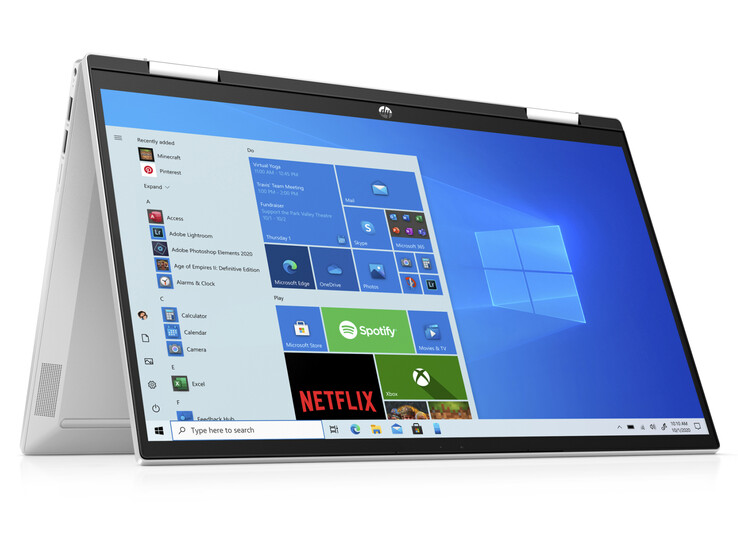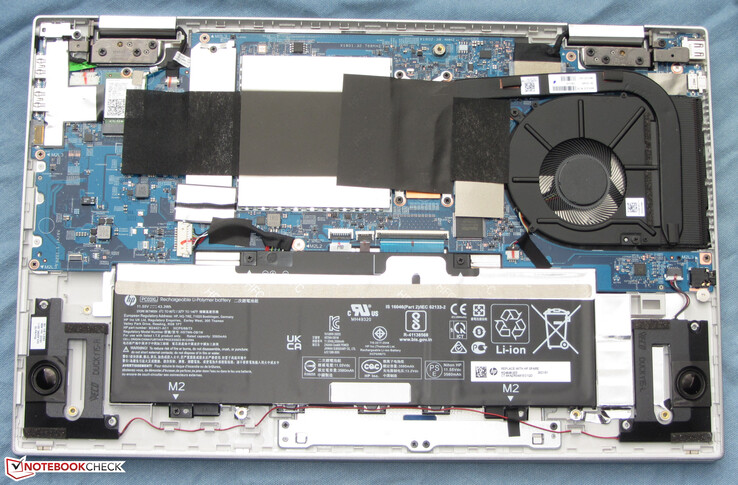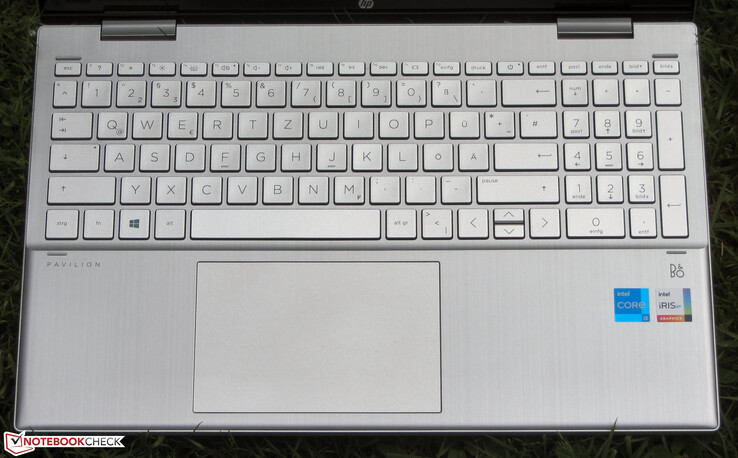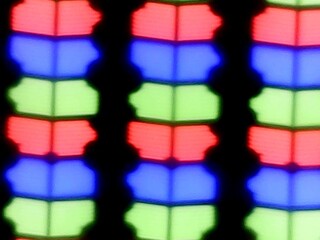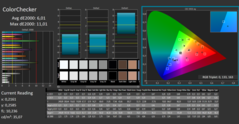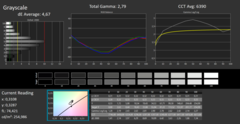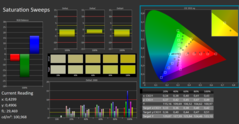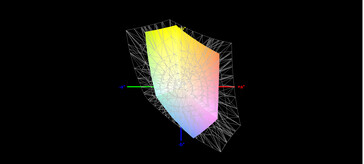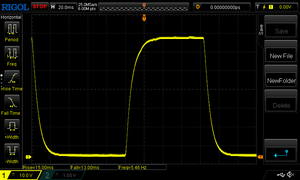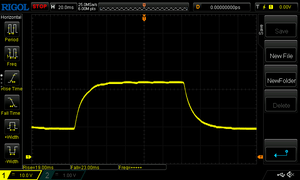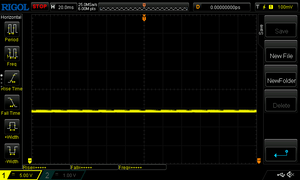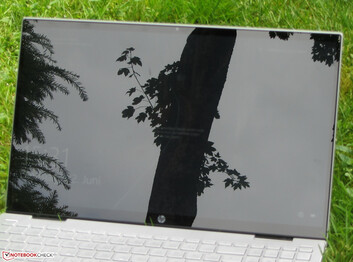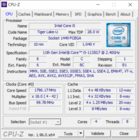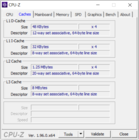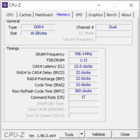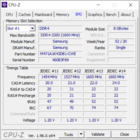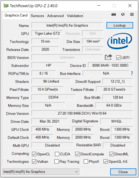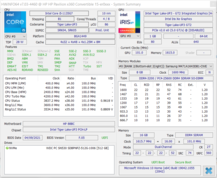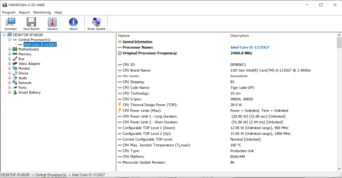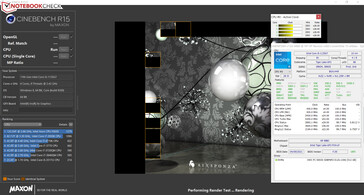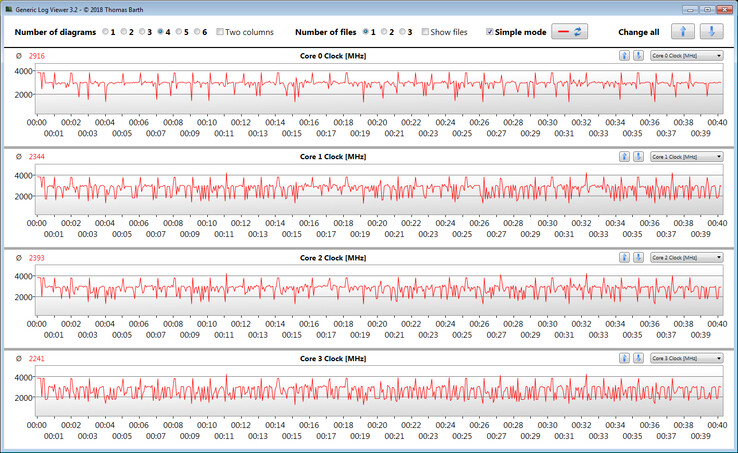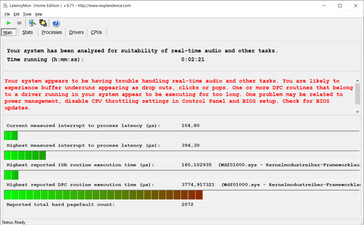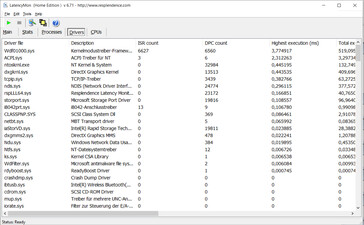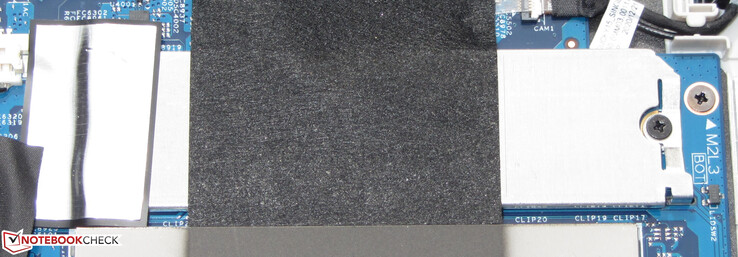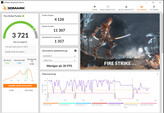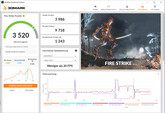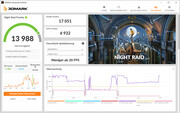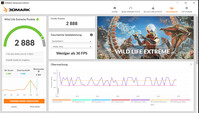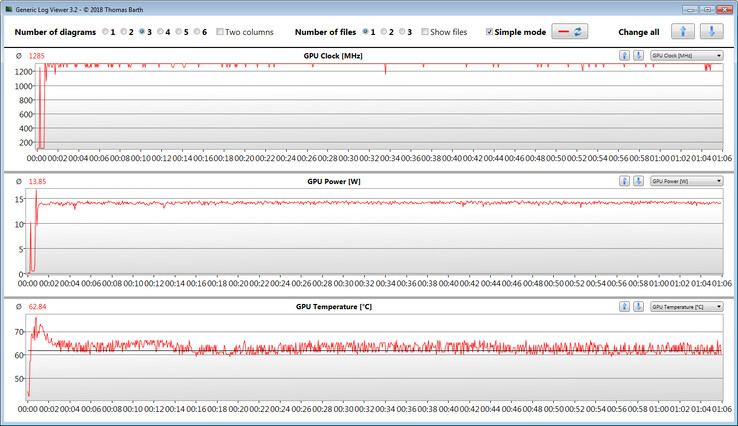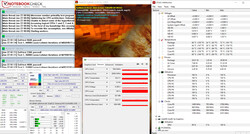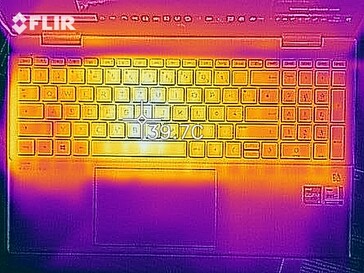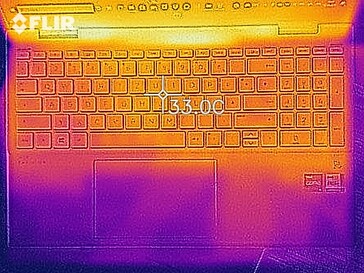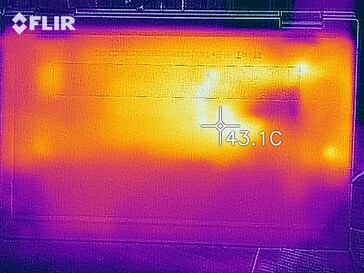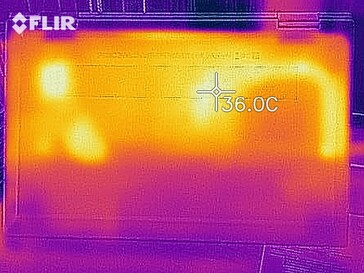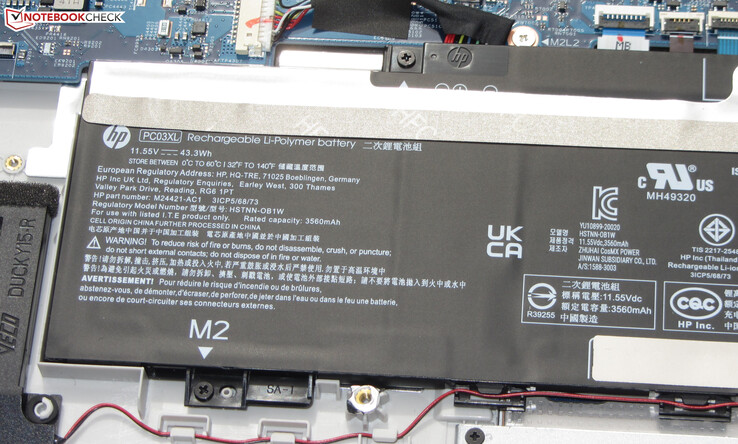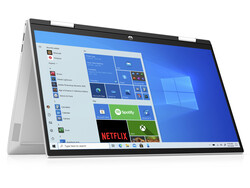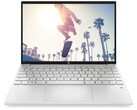HP Pavilion x360 15-inch (2021) 2-in-1 Laptop Review: Dim screen, high price ↺

The HP Pavilion x360 15 is a 15.6-inch 2-in-1 device. It is powered by the Core i5-1135G7. The competing devices include: the HP Envy x360 15, the Lenovo IdeaPad Flex 5 14ALC05, the Acer Spin 3 SP314-54N, and the Asus VivoBook Flip 14 TP470EZ.
Likely Competitors
Rating | Date | Model | Weight | Height | Size | Resolution | Price |
|---|---|---|---|---|---|---|---|
| 80.8 % v7 (old) | 07 / 2021 | HP Pavilion x360 15-er0155ng i5-1135G7, Iris Xe G7 80EUs | 1.8 kg | 19.9 mm | 15.60" | 1920x1080 | |
| 86.4 % v7 (old) | 05 / 2021 | HP Envy x360 15-eu0097nr R7 5700U, Vega 8 | 1.9 kg | 18.4 mm | 15.60" | 1920x1080 | |
| 79.2 % v7 (old) | 05 / 2021 | Lenovo IdeaPad Flex 5 14ALC05 82HU002YUS R7 5700U, Vega 8 | 1.6 kg | 20.8 mm | 14.00" | 1920x1080 | |
| 84.2 % v7 (old) | 03 / 2021 | Acer Spin 3 SP314-54N-56S5 i5-1035G4, Iris Plus Graphics G4 (Ice Lake 48 EU) | 1.5 kg | 16 mm | 14.00" | 1920x1080 | |
| 79.1 % v7 (old) | 06 / 2021 | Asus VivoBook Flip 14 TP470EZ i5-1135G7, Xe MAX | 1.5 kg | 18.7 mm | 14.00" | 1920x1080 |
Case - The wrist rest area is not rigid
The housing of the HP Pavilion x360 is made of plastic. The display lid and the top of the chassis have a non-reflective silver-coloured surface which feels smooth to the touch. The wrist rest area has a texture which resembles brushed aluminium. The back plate has a rough surface and a greyish colour. You can't replace the battery without disassembling the laptop first. There is no quick maintenance hatch, either.
The build quality is solid. We did not notice any defects such as chinks where different pieces of plastic meet. However, the chassis is not very rigid. A small amount of pressure is sufficient to bend in the housing on either side of the keyboard. However, the display lid is quite stiff.
The hinges can hold the display in a set position. The display lid can be opened with one hand. When fully open, the display lid raises slightly the upper portion of the chassis.
The Pavilion x360 and the HP Envy 15 are the largest and heaviest devices in our comparison chart. However, other competitors have 14-inch screens.
Connectivity - HP convertible supports Power Delivery over USB-C
The Pavilion x360 features two USB-A ports (USB 3.2 Gen 1) and one USB-C port (USB 3.2 Gen 2). The Type-C port supports Power Delivery and can output a DisplayPort signal. There is also an HDMI port. The Pavilion x360 comes with HP’s proprietary charging port. Alternately, the laptop can be charged with the help of a USB-C power adapter (45 W minimum).
Card Reader
The microSD card reader achieved very good data transfer rates with our reference-grade SD card (Angelbird AV PRO microSD 128 GB V60). When copying JPG files, we saw a maximum transfer rate of 74.3 MB/s. When copying large files, the transfer rates peaked at 85.3 MB/s.
| SD Card Reader | |
| average JPG Copy Test (av. of 3 runs) | |
| Lenovo IdeaPad Flex 5 14ALC05 82HU002YUS (AV PRO microSD 128 GB V60) | |
| HP Envy x360 15-eu0097nr (AV PRO microSD 128 GB V60) | |
| HP Pavilion x360 15-er0155ng (AV PRO microSD 128 GB V60) | |
| Average of class Convertible (28.1 - 209, n=23, last 2 years) | |
| Asus VivoBook Flip 14 TM420IA (Toshiba Exceria Pro M501 microSDXC 64GB) | |
| Acer Spin 3 SP314-54N-56S5 (Toshiba Exceria Pro M501 microSDXC 64GB) | |
| maximum AS SSD Seq Read Test (1GB) | |
| Average of class Convertible (28.9 - 253, n=22, last 2 years) | |
| Lenovo IdeaPad Flex 5 14ALC05 82HU002YUS (AV PRO microSD 128 GB V60) | |
| HP Pavilion x360 15-er0155ng (AV PRO microSD 128 GB V60) | |
| HP Envy x360 15-eu0097nr (AV PRO microSD 128 GB V60) | |
| Asus VivoBook Flip 14 TM420IA (Toshiba Exceria Pro M501 microSDXC 64GB) | |
| Acer Spin 3 SP314-54N-56S5 (Toshiba Exceria Pro M501 microSDXC 64GB) | |
Communication
The Wi-Fi module (Intel Wireless-AC 9461) supports the following Wi-Fi standards: 802.11a, b, g, n, and ac. Bluetooth 5 is also supported. The Pavilion x360 did not achieve good data transfer rates in our Wi-Fi test which is to be expected considering the Wi-Fi card is not designed to break past the 433 Mb/s limit.
Web Camera
The Pavilion x360 has a low-resolution 0.9-MP web camera which produces subpar photos and videos. The colour reproduction is especially poor with a DeltaE 2000 of 22 (the ideal value is less than 3).
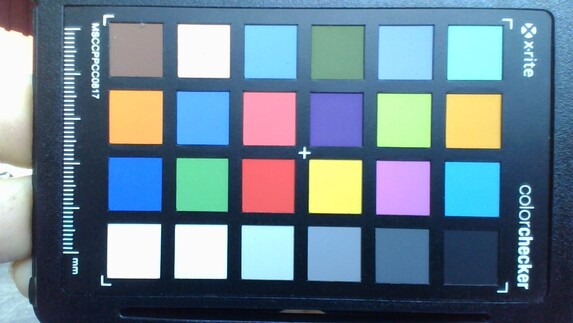
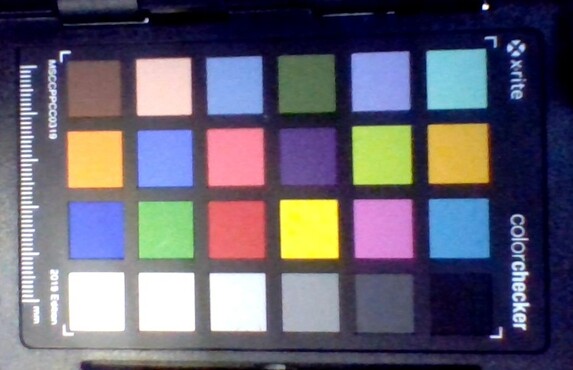
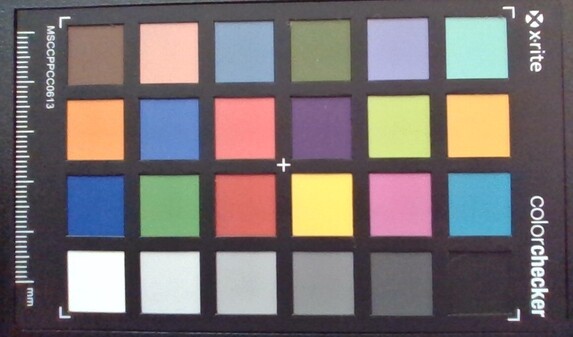
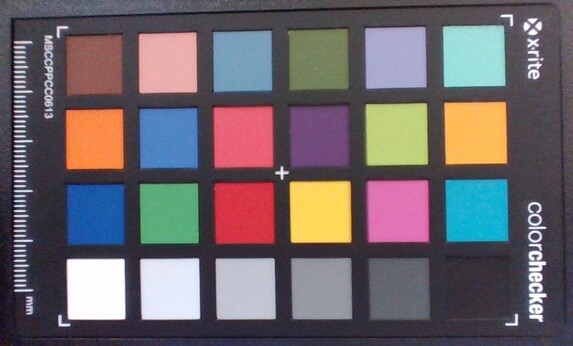
Accessories
The box contains the usual accessories (warranty information, quick start guide).
Maintenance
The bottom plate of the Pavilion x360 can be removed. To do this, all screws on the underside need to be undone. It is worth mentioning that there are screws under the rubber feet, which are quite brittle and therefore need to be removed with care. After all the screws are undone, the bottom cover can be removed with the help of a spudger or a guitar pick.
Warranty
The Pavilion x360 comes with a 12-month warranty. A two-year warranty extension will cost buyers an additional 50 Euros (~ $60).
Input Devices - Backlit keyboard
Keyboard
The chiclet-style keyboard offers a decent travel distance and a clear actuation point. However, the keys feel a little mushy. The keyboard deck exhibits some flex when typing. The backlight offers two luminance levels. All in all, the Pavilion x360 has a decent keyboard.
TouchPad
Touchscreen
Display - Dim IPS panel
Both the brightness (246.1 cd/m²) and the contrast ratio (859:1) are too low. When running on battery power, the maximum brightness amounts to only 216 cd/m². As a rule, we consider a screen brightness of at least 300 cd/m² and a contrast ratio of at least 1000:1 to be good.
| |||||||||||||||||||||||||
Brightness Distribution: 93 %
Center on Battery: 216 cd/m²
Contrast: 859:1 (Black: 0.29 cd/m²)
ΔE ColorChecker Calman: 6.01 | ∀{0.5-29.43 Ø4.78}
ΔE Greyscale Calman: 4.67 | ∀{0.09-98 Ø5}
59% sRGB (Argyll 1.6.3 3D)
38% AdobeRGB 1998 (Argyll 1.6.3 3D)
41.1% AdobeRGB 1998 (Argyll 3D)
59.7% sRGB (Argyll 3D)
39.8% Display P3 (Argyll 3D)
Gamma: 2.79
CCT: 6390 K
| HP Pavilion x360 15-er0155ng AU Optronics AUOC48A, IPS, 1920x1080, 15.6" | HP Envy x360 15-eu0097nr AUOA08B, IPS, 1920x1080, 15.6" | Lenovo IdeaPad Flex 5 14ALC05 82HU002YUS Chi Mei N140HCA-E5B, IPS, 1920x1080, 14" | Acer Spin 3 SP314-54N-56S5 BOE081D, IPS, 1920x1080, 14" | Asus VivoBook Flip 14 TP470EZ Chi Mei CMN N140HCA-EAC, IPS, 1920x1080, 14" | |
|---|---|---|---|---|---|
| Display | 70% | 6% | -2% | 5% | |
| Display P3 Coverage (%) | 39.8 | 69 73% | 42.32 6% | 39.25 -1% | 41.6 5% |
| sRGB Coverage (%) | 59.7 | 99.1 66% | 62.7 5% | 58.2 -3% | 62.1 4% |
| AdobeRGB 1998 Coverage (%) | 41.1 | 70.1 71% | 43.87 7% | 40.55 -1% | 43 5% |
| Response Times | -45% | 13% | 37% | 4% | |
| Response Time Grey 50% / Grey 80% * (ms) | 42 ? | 60.4 ? -44% | 38.4 ? 9% | 29 ? 31% | 39 ? 7% |
| Response Time Black / White * (ms) | 28 ? | 40.8 ? -46% | 23.2 ? 17% | 16 ? 43% | 28 ? -0% |
| PWM Frequency (Hz) | 1000 ? | 25000 ? | |||
| Screen | 47% | -18% | 23% | -6% | |
| Brightness middle (cd/m²) | 249 | 337.2 35% | 236.7 -5% | 271 9% | 205 -18% |
| Brightness (cd/m²) | 246 | 337 37% | 221 -10% | 272 11% | 186 -24% |
| Brightness Distribution (%) | 93 | 87 -6% | 81 -13% | 92 -1% | 78 -16% |
| Black Level * (cd/m²) | 0.29 | 0.24 17% | 0.2 31% | 0.19 34% | 0.22 24% |
| Contrast (:1) | 859 | 1405 64% | 1184 38% | 1426 66% | 932 8% |
| Colorchecker dE 2000 * | 6.01 | 1.73 71% | 7.83 -30% | 4.24 29% | 5.14 14% |
| Colorchecker dE 2000 max. * | 11.01 | 3.69 66% | 23.74 -116% | 6.38 42% | 19.57 -78% |
| Greyscale dE 2000 * | 4.67 | 2.3 51% | 8.6 -84% | 2.51 46% | 4.1 12% |
| Gamma | 2.79 79% | 2.19 100% | 1.96 112% | 2.25 98% | 2.2 100% |
| CCT | 6390 102% | 6872 95% | 5901 110% | 6812 95% | 6807 95% |
| Color Space (Percent of AdobeRGB 1998) (%) | 38 | 64.1 69% | 40.3 6% | 37 -3% | 43.04 13% |
| Color Space (Percent of sRGB) (%) | 59 | 99.6 69% | 62.3 6% | 58 -2% | 62.1 5% |
| Colorchecker dE 2000 calibrated * | 1.61 | 3.8 | 3.17 | ||
| Total Average (Program / Settings) | 24% /
40% | 0% /
-9% | 19% /
20% | 1% /
-3% |
* ... smaller is better
Right out of the box, the screen offers a decent colour reproduction. However, with a DeltaE 2000 colour deviation of 6, the display misses the mark (DeltaE less than 3) considerably. The display does not suffer from a bluish cast. The HP laptop cannot cover both the sRGB colour space and the Adobe RGB colour space. It can only cover 59% of sRGB and 38% of Adobe RGB.
Display Response Times
| ↔ Response Time Black to White | ||
|---|---|---|
| 28 ms ... rise ↗ and fall ↘ combined | ↗ 15 ms rise | |
| ↘ 13 ms fall | ||
| The screen shows relatively slow response rates in our tests and may be too slow for gamers. In comparison, all tested devices range from 0.1 (minimum) to 240 (maximum) ms. » 70 % of all devices are better. This means that the measured response time is worse than the average of all tested devices (20.2 ms). | ||
| ↔ Response Time 50% Grey to 80% Grey | ||
| 42 ms ... rise ↗ and fall ↘ combined | ↗ 19 ms rise | |
| ↘ 23 ms fall | ||
| The screen shows slow response rates in our tests and will be unsatisfactory for gamers. In comparison, all tested devices range from 0.165 (minimum) to 636 (maximum) ms. » 66 % of all devices are better. This means that the measured response time is worse than the average of all tested devices (31.6 ms). | ||
Screen Flickering / PWM (Pulse-Width Modulation)
| Screen flickering / PWM not detected | |||
In comparison: 53 % of all tested devices do not use PWM to dim the display. If PWM was detected, an average of 8118 (minimum: 5 - maximum: 343500) Hz was measured. | |||
Performance - Powerful enough for office and web-based applications
The HP Pavilion x360 is a 15-inch 2-in-1 laptop. It offers enough performance for web browsing and office work.
Processor
The Pavilion x360 comes with Intel’s Tiger Lake-based Core i5-1135G7 which features four cores with a base clock of 2.4 GHz. Thanks to Intel’s Turbo Boost technology, the clock rate can be increased up to 3.8 GHz for all cores and 4.2 GHz for a single core. The processor supports Intel’s Hyper-Threading technology (one core can process two threads at the same time).
The CPU runs for a short time at 3.8 GHz in the multi-core section of the CineBench R15 benchmark. Then the clock rate starts to fluctuate between 1.7 GHz and 3 GHz. The clock speeds range from 1.7 to 4.2 GHz in the single-core section of the benchmark. When running on battery power, the performance of the processor drops significantly.
When compared to other laptops with the Core i5-1135G7, the Pavilion x360 leaves a rather mixed impression. It offers a very high level of single-core performance, but it achieves only mediocre results in the heavily threaded benchmarks.
We check whether or not Intel’s Turbo Boost technology can be used over an extended period of time by running the multi-core section of the CineBench R15 benchmark for 30 straight minutes in a continuous loop. The clock rates fall considerably shortly after the benchmark is initiated. All in all, the Turbo Boost technology is not fully utilised.
* ... smaller is better
System Performance
The system runs smoothly. We did not encounter any problems. The laptop offers more than enough performance for such usage scenarios as office work and Internet browsing. The notebook achieves good results in the PCMark benchmarks. The HP laptop features 16 GB of RAM (dual-channel; DDR4 3200). The amount of RAM can be increased.
| PCMark 8 Home Score Accelerated v2 | 4141 points | |
| PCMark 8 Creative Score Accelerated v2 | 4700 points | |
| PCMark 8 Work Score Accelerated v2 | 3069 points | |
| PCMark 10 Score | 4596 points | |
Help | ||
DPC Latencies
| DPC Latencies / LatencyMon - interrupt to process latency (max), Web, Youtube, Prime95 | |
| Lenovo IdeaPad Flex 5 14ALC05 82HU002YUS | |
| HP Envy x360 15-eu0097nr | |
| Acer Spin 3 SP314-54N-56S5 | |
| Asus VivoBook Flip 14 TM420IA | |
| Asus VivoBook Flip 14 TP470EZ | |
| HP Pavilion x360 15-er0155ng | |
* ... smaller is better
Storage Devices
| HP Pavilion x360 15-er0155ng WDC PC SN530 SDBPNPZ-512G | HP Envy x360 15-eu0097nr WDC PC SN530 SDBPNPZ-512G | Lenovo IdeaPad Flex 5 14ALC05 82HU002YUS WDC PC SN530 SDBPMPZ-265G | Acer Spin 3 SP314-54N-56S5 SK hynix BC511 HFM256GDJTNI-82A0 | Asus VivoBook Flip 14 TP470EZ Intel SSD 660p SSDPEKNW512G8 | Average WDC PC SN530 SDBPNPZ-512G | |
|---|---|---|---|---|---|---|
| CrystalDiskMark 5.2 / 6 | -13% | -12% | -32% | -24% | -13% | |
| Write 4K (MB/s) | 231.6 | 161 -30% | 161 -30% | 165.2 -29% | 200.2 -14% | 170.1 ? -27% |
| Read 4K (MB/s) | 57.3 | 44.54 -22% | 49.96 -13% | 55 -4% | 58.6 2% | 49.4 ? -14% |
| Write Seq (MB/s) | 1796 | 1761 -2% | 1840 2% | 1015 -43% | 983 -45% | 1731 ? -4% |
| Read Seq (MB/s) | 1903 | 1645 -14% | 1989 5% | 1125 -41% | 1623 -15% | 1643 ? -14% |
| Write 4K Q32T1 (MB/s) | 555 | 533 -4% | 354.1 -36% | 423.6 -24% | 547 -1% | 453 ? -18% |
| Read 4K Q32T1 (MB/s) | 625 | 420.3 -33% | 452.3 -28% | 483.8 -23% | 345.1 -45% | 488 ? -22% |
| Write Seq Q32T1 (MB/s) | 1791 | 1835 2% | 1842 3% | 648 -64% | 985 -45% | 1791 ? 0% |
| Read Seq Q32T1 (MB/s) | 2459 | 2430 -1% | 2447 0% | 1802 -27% | 1840 -25% | 2272 ? -8% |
| Write 4K Q8T8 (MB/s) | 849 | |||||
| Read 4K Q8T8 (MB/s) | 345.9 | |||||
| AS SSD | -27% | -31% | -25% | -19% | -6% | |
| Seq Read (MB/s) | 2084 | 2043 -2% | 2159 4% | 1871 -10% | 1684 -19% | 1862 ? -11% |
| Seq Write (MB/s) | 1687 | 1118 -34% | 1753 4% | 703 -58% | 901 -47% | 1392 ? -17% |
| 4K Read (MB/s) | 42.64 | 40.43 -5% | 30.99 -27% | 45.97 8% | 54.6 28% | 42.1 ? -1% |
| 4K Write (MB/s) | 137.2 | 157.6 15% | 133.7 -3% | 119.3 -13% | 182.3 33% | 163.8 ? 19% |
| 4K-64 Read (MB/s) | 927 | 752 -19% | 762 -18% | 614 -34% | 322.4 -65% | 813 ? -12% |
| 4K-64 Write (MB/s) | 792 | 414.1 -48% | 394.6 -50% | 367.1 -54% | 803 1% | 876 ? 11% |
| Access Time Read * (ms) | 0.132 | 0.063 52% | 0.072 45% | 0.084 36% | 0.151 -14% | 0.07875 ? 40% |
| Access Time Write * (ms) | 0.049 | 0.167 -241% | 0.172 -251% | 0.038 22% | 0.045 8% | 0.08225 ? -68% |
| Score Read (Points) | 1178 | 997 -15% | 1009 -14% | 847 -28% | 545 -54% | 1041 ? -12% |
| Score Write (Points) | 1098 | 684 -38% | 704 -36% | 557 -49% | 1075 -2% | 1179 ? 7% |
| Score Total (Points) | 2866 | 2153 -25% | 2212 -23% | 1792 -37% | 1881 -34% | 2738 ? -4% |
| Copy ISO MB/s (MB/s) | 1349 | 1344 0% | 1148 -15% | 1168 -13% | 1058 -22% | 1427 ? 6% |
| Copy Program MB/s (MB/s) | 762 | 630 -17% | 490.2 -36% | 459.8 -40% | 422.8 -45% | 612 ? -20% |
| Copy Game MB/s (MB/s) | 1291 | 1220 -5% | 1068 -17% | 283 -78% | 850 -34% | 1001 ? -22% |
| Total Average (Program / Settings) | -20% /
-22% | -22% /
-24% | -29% /
-27% | -22% /
-21% | -10% /
-9% |
* ... smaller is better
Continuous read speed: DiskSpd Read Loop, Queue Depth 8
Graphics Card
Intel’s Iris Xe Graphics G7 (80EU) supports DirectX 12 and can achieve core clocks of up to 1300 MHz. In our gaming stress test with The Witcher 3, the integrated GPU did not throttle. The GPU performed as expected in the 3DMark benchmarks.
| 3DMark 11 Performance | 5915 points | |
| 3DMark Ice Storm Standard Score | 80033 points | |
| 3DMark Cloud Gate Standard Score | 15861 points | |
| 3DMark Fire Strike Score | 3721 points | |
| 3DMark Time Spy Score | 1419 points | |
Help | ||
Gaming Performance
Even though the 2-in-1 laptop is not meant for gaming, it can still achieve playable frame rates in many games—on low settings and at low resolutions. However, the iGPU will not be able to handle the latest AAA titles.
| The Witcher 3 - 1366x768 Medium Graphics & Postprocessing | |
| Average of class Convertible (39 - 210, n=16, last 2 years) | |
| HP Envy x360 15-eu0097nr | |
| HP Pavilion x360 15-er0155ng | |
| Average Intel Iris Xe Graphics G7 80EUs (21.8 - 56.9, n=103) | |
| Asus VivoBook Flip 14 TM420IA | |
| Asus VivoBook Flip 14 TP470EZ | |
| Acer Spin 3 SP314-54N-56S5 | |
We use the video game known as The Witcher 3 to check whether the frame rates can be maintained consistently over an extended period of time. For this, we run the game on the highest graphics settings at Full HD resolution (1920x1080) for one hour. Over the entire run of gameplay, the player-controlled character stands still. We did not observe any frame rate drops.
| low | med. | high | ultra | |
|---|---|---|---|---|
| GTA V (2015) | 85.9 | 71.4 | 23.4 | 9.4 |
| The Witcher 3 (2015) | 71.4 | 47.7 | 25.9 | 13.6 |
| Dota 2 Reborn (2015) | 81.6 | 54.2 | 40 | 38.9 |
| Final Fantasy XV Benchmark (2018) | 31 | 17.4 | 13.4 | |
| X-Plane 11.11 (2018) | 40.6 | 34.4 | 31 | |
| Strange Brigade (2018) | 75 | 31.3 | 25.2 | 20.3 |
| Star Wars Squadrons (2020) | 91.5 | 38 | 32.3 | 29 |
| Dirt 5 (2020) | 35.5 | 15.7 | 12.6 | 10.3 |
| Outriders (2021) | 32.9 | 26.1 | 22.4 | 20.8 |
| Resident Evil Village (2021) | 31.2 | 20.6 | 19 | |
| Mass Effect Legendary Edition (2021) | 49 | 32.4 | ||
| Days Gone (2021) | 24 | 18.7 | 16.6 | 12.2 |
Emissions - The HP laptop is quiet most of the time
System Noise
When idle, the system is often completely silent. Under load, the fan is not spinning very fast. During our stress test, the fan noise peaked at 39.6 dB(A).
Noise level
| Idle |
| 26 / 26 / 26 dB(A) |
| Load |
| 35.1 / 39.6 dB(A) |
 | ||
30 dB silent 40 dB(A) audible 50 dB(A) loud |
||
min: | ||
| HP Pavilion x360 15-er0155ng i5-1135G7, Iris Xe G7 80EUs | HP Envy x360 15-eu0097nr R7 5700U, Vega 8 | Lenovo IdeaPad Flex 5 14ALC05 82HU002YUS R7 5700U, Vega 8 | Acer Spin 3 SP314-54N-56S5 i5-1035G4, Iris Plus Graphics G4 (Ice Lake 48 EU) | Asus VivoBook Flip 14 TP470EZ i5-1135G7, Xe MAX | Average Intel Iris Xe Graphics G7 80EUs | Average of class Convertible | |
|---|---|---|---|---|---|---|---|
| Noise | 8% | -2% | 6% | -13% | 1% | 4% | |
| off / environment * (dB) | 26 | 25 4% | 24.6 5% | 24.9 4% | 29.95 -15% | 25 ? 4% | 23.8 ? 8% |
| Idle Minimum * (dB) | 26 | 25.1 3% | 24.9 4% | 24.9 4% | 29.95 -15% | 25.3 ? 3% | 24.1 ? 7% |
| Idle Average * (dB) | 26 | 25.1 3% | 24.9 4% | 24.9 4% | 29.95 -15% | 25.5 ? 2% | 24.6 ? 5% |
| Idle Maximum * (dB) | 26 | 25.1 3% | 24.9 4% | 26 -0% | 29.95 -15% | 26.5 ? -2% | 25.3 ? 3% |
| Load Average * (dB) | 35.1 | 26.3 25% | 41.1 -17% | 32.6 7% | 39.84 -14% | 34.7 ? 1% | 33.6 ? 4% |
| Load Maximum * (dB) | 39.6 | 35.5 10% | 43.5 -10% | 32.8 17% | 39.84 -1% | 40.2 ? -2% | 41.2 ? -4% |
| Witcher 3 ultra * (dB) | 30.8 | 43.5 | 42.3 |
* ... smaller is better
Temperature
In our stress test (Prime95 and FurMark running continuously for at least one hour), the processor operated at 900 to 1500 MHz and the GPU ran at 700 MHz. The stress test is an extreme case scenario, which is very unlikely to occur in real life. We use it to test system stability.
The Pavilion x360 does not get considerably hot. During our stress test, the 40-°C (104 °F) mark was exceeded at two measurement points. In day-to-day use, the temperatures always remain reasonable.
(+) The maximum temperature on the upper side is 39.9 °C / 104 F, compared to the average of 35.4 °C / 96 F, ranging from 19.6 to 60 °C for the class Convertible.
(±) The bottom heats up to a maximum of 43.1 °C / 110 F, compared to the average of 36.8 °C / 98 F
(+) In idle usage, the average temperature for the upper side is 24.9 °C / 77 F, compared to the device average of 30.3 °C / 87 F.
(+) The palmrests and touchpad are reaching skin temperature as a maximum (33.7 °C / 92.7 F) and are therefore not hot.
(-) The average temperature of the palmrest area of similar devices was 27.9 °C / 82.2 F (-5.8 °C / -10.5 F).
| HP Pavilion x360 15-er0155ng i5-1135G7, Iris Xe G7 80EUs | HP Envy x360 15-eu0097nr R7 5700U, Vega 8 | Lenovo IdeaPad Flex 5 14ALC05 82HU002YUS R7 5700U, Vega 8 | Acer Spin 3 SP314-54N-56S5 i5-1035G4, Iris Plus Graphics G4 (Ice Lake 48 EU) | Asus VivoBook Flip 14 TP470EZ i5-1135G7, Xe MAX | Average Intel Iris Xe Graphics G7 80EUs | Average of class Convertible | |
|---|---|---|---|---|---|---|---|
| Heat | 1% | -27% | 11% | -5% | -4% | -3% | |
| Maximum Upper Side * (°C) | 39.9 | 39.6 1% | 52.8 -32% | 33.9 15% | 41 -3% | 40.5 ? -2% | 40.8 ? -2% |
| Maximum Bottom * (°C) | 43.1 | 44.4 -3% | 42.8 1% | 35.1 19% | 41.2 4% | 43.6 ? -1% | 43.3 ? -0% |
| Idle Upper Side * (°C) | 26.3 | 23.6 10% | 31.8 -21% | 25 5% | 29.6 -13% | 27.9 ? -6% | 27.9 ? -6% |
| Idle Bottom * (°C) | 27.4 | 28.2 -3% | 43 -57% | 25.8 6% | 30 -9% | 29.2 ? -7% | 28.7 ? -5% |
* ... smaller is better
Speakers
The stereo speakers produce a decent sound. However, the low frequencies are almost completely missing. We recommend using a set of headphones or external speakers for a better listening experience.
HP Pavilion x360 15-er0155ng audio analysis
(±) | speaker loudness is average but good (78.9 dB)
Bass 100 - 315 Hz
(-) | nearly no bass - on average 19.6% lower than median
(±) | linearity of bass is average (13.7% delta to prev. frequency)
Mids 400 - 2000 Hz
(+) | balanced mids - only 1.7% away from median
(+) | mids are linear (3.1% delta to prev. frequency)
Highs 2 - 16 kHz
(±) | higher highs - on average 6.5% higher than median
(±) | linearity of highs is average (9.8% delta to prev. frequency)
Overall 100 - 16.000 Hz
(±) | linearity of overall sound is average (16.9% difference to median)
Compared to same class
» 31% of all tested devices in this class were better, 7% similar, 62% worse
» The best had a delta of 6%, average was 20%, worst was 57%
Compared to all devices tested
» 29% of all tested devices were better, 8% similar, 63% worse
» The best had a delta of 4%, average was 24%, worst was 134%
Energy Management - HP’s 2-in-1 laptop offers decent battery runtimes
Energy Consumption
When idle, the power consumption peaked at 10.4 W. During our stress test (Prime95 and FurMark running continuously for at least one hour), the energy consumption reached 34.6 W—a very good result for this CPU. However, both the CPU and the GPU throttled considerably during our stress test. The power draw was very stable in our gaming stress test. The rated output of the AC adapter amounts to 45 W.
| Off / Standby | |
| Idle | |
| Load |
|
Key:
min: | |
| HP Pavilion x360 15-er0155ng i5-1135G7, Iris Xe G7 80EUs | HP Envy x360 15-eu0097nr R7 5700U, Vega 8 | Lenovo IdeaPad Flex 5 14ALC05 82HU002YUS R7 5700U, Vega 8 | Acer Spin 3 SP314-54N-56S5 i5-1035G4, Iris Plus Graphics G4 (Ice Lake 48 EU) | Asus VivoBook Flip 14 TP470EZ i5-1135G7, Xe MAX | Average Intel Iris Xe Graphics G7 80EUs | Average of class Convertible | |
|---|---|---|---|---|---|---|---|
| Power Consumption | -7% | -9% | 11% | -66% | -9% | -18% | |
| Idle Minimum * (Watt) | 5.4 | 3.5 35% | 4 26% | 3.4 37% | 8.6 -59% | 4.47 ? 17% | 4.43 ? 18% |
| Idle Average * (Watt) | 8.8 | 5.7 35% | 6.6 25% | 6 32% | 9.56 -9% | 7.37 ? 16% | 7.38 ? 16% |
| Idle Maximum * (Watt) | 10.4 | 5.8 44% | 7 33% | 7.9 24% | 25.82 -148% | 9.24 ? 11% | 9.78 ? 6% |
| Load Average * (Watt) | 33 | 46 -39% | 42.6 -29% | 39.6 -20% | 47 -42% | 36.6 ? -11% | 45 ? -36% |
| Witcher 3 ultra * (Watt) | 33.6 | 42.1 -25% | 40.8 -21% | 45.9 -37% | |||
| Load Maximum * (Watt) | 34.6 | 65.4 -89% | 65.5 -89% | 41 -18% | 69.48 -101% | 61.7 ? -78% | 67.1 ? -94% |
* ... smaller is better
Battery Life
The Pavilion x360 lasted 6h and 48m in our Wi-Fi test, which we conduct by running a script that simulates loads that are consistent with browsing the Internet. In our video test (playing back an H.264 video in a loop), the HP laptop lasted 7h and 45m. System settings: The power saving functions are disabled and the brightness is set to 150 cd/m². Moreover, the communications modules are switched off in the video test.
| HP Pavilion x360 15-er0155ng i5-1135G7, Iris Xe G7 80EUs, 43.3 Wh | HP Envy x360 15-eu0097nr R7 5700U, Vega 8, 51 Wh | Lenovo IdeaPad Flex 5 14ALC05 82HU002YUS R7 5700U, Vega 8, 52 Wh | Acer Spin 3 SP314-54N-56S5 i5-1035G4, Iris Plus Graphics G4 (Ice Lake 48 EU), 48 Wh | Asus VivoBook Flip 14 TP470EZ i5-1135G7, Xe MAX, 42 Wh | Average of class Convertible | |
|---|---|---|---|---|---|---|
| Battery runtime | 61% | 13% | -1% | 7% | 55% | |
| Reader / Idle (h) | 17.2 | 23.8 38% | 16.4 -5% | 14 -19% | 25.1 ? 46% | |
| H.264 (h) | 7.8 | 8.3 6% | 15.2 ? 95% | |||
| WiFi v1.3 (h) | 6.8 | 9.9 46% | 12.3 81% | 7.5 10% | 7.3 7% | 11.2 ? 65% |
| Load (h) | 1.6 | 3.2 100% | 1 -37% | 1.6 0% | 1.793 ? 12% | |
| Witcher 3 ultra (h) | 1.7 |
Pros
Cons
Verdict - A lot of room for improvement
The HP Pavilion x360 15 features the Core i5-1135G7, 16 GB of dual-channel RAM and an NVMe SSD. This is why it can handle all modern tasks. The HP laptop never gets too loud or too hot.
HP’s 2-in-1 device has too many flaws, given its price tag.
The Pavilion x360 is not suited for very demanding CPU workloads because its processor throttles under heavy loads. The CPU provides enough performance for normal tasks, though.
The battery life is decent (7 to 8 hours). However, we were expecting more from a Pavilion device (9 to 10 hours). Furthermore, the laptop ships with a one-year warranty and a really slow Wi-Fi module. All in all, an 800-Euro (~$950) device should offer more.
The touchscreen (FHD, IPS) disappoints: The brightness and the contrast ratio are too low. However, it can be used with the fingers or the HP Tilt Pen MPP2.0 (3J122AA; €80/$95), which is sold separately.
Price and Availability
The HP Pavilion x360 2-in-1 15 with a Core i5-10210U, 8GB of RAM and a 512 GB SSD is currently available on Amazon for $849.
HP Pavilion x360 15-er0155ng
- 06/28/2021 v7 (old)
Sascha Mölck




